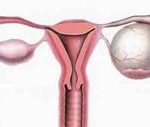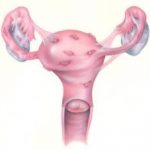Diseases of the internal genital organs of the female are treated nowadays mostly with minimally  invasive surgical approaches, involving both laparoscopic and robotic surgery.
invasive surgical approaches, involving both laparoscopic and robotic surgery.
Uterus has normally the size and shape of a reversed small pear and its function is to hospitalise the fetus during pregnancy until labor. Uterus is connected with the ovaries through the oviducts, which carry the ovum from the place of its production the ovary, to uterus for possible fertilization and finally the implantation of the fetus. The lower portion of the uterus is the cervix, which ends to the vagina.
Diagnostic approach of the diseases of the internal genital organs of the female is done through ultrasound, CT and MRI scans. In complicated cases uteroscopy and diagnostic abrasion is performed.
Benign diseases
The most usual benign gynaecological diseases are:
 Fibromyomasare benign tumors that are formed in the uterus. They are found in the 20-40% of women, more often in reproductive age and they have a small potential of becoming malignant, about 0,5%. Their cause is in fact unknown, although there are some indications that they may result from some kind of mutation of a single muscular cell of the uterus and their growth is related with the oestrogen levels.
Fibromyomasare benign tumors that are formed in the uterus. They are found in the 20-40% of women, more often in reproductive age and they have a small potential of becoming malignant, about 0,5%. Their cause is in fact unknown, although there are some indications that they may result from some kind of mutation of a single muscular cell of the uterus and their growth is related with the oestrogen levels.
Possible symptoms related to fibromyomas include vaginal bleeding, feeling of pressure in the lower abdomen and pain. Sometimes, fibromyomas may affect normal fertilization and pregnancy.
 Serosal Cysts are follicles that they did not end in ovulation at the end of the circle, instead they continued functioning, taking the form of a cyst. This kind of “cystic follicles” can reach a size larger than 5 cm.
Serosal Cysts are follicles that they did not end in ovulation at the end of the circle, instead they continued functioning, taking the form of a cyst. This kind of “cystic follicles” can reach a size larger than 5 cm.
Symptoms may include menstruation disorders and pain. Simple cysts are quite often without necessarily requiring treatment, once they often disappear from their own. In case of persistence, contraceptive pills are prescribed for a short period of time. Rarely, it is possible to become very large, to undergo contortion and be strangled, to rupture or even cause acute abdomen, a situation requiring immediate surgical treatment.
 Endometriosis is a situation in which the tissue that covers the internal surface of the uterus (endometrium) is developed outside of uteral cavity, inside the abdomen, which is not normally located, such the external surface of the uterus, the ovaries or elsewhere. When endometrial implantations are located in the ovarian surface, blood can penetrate inside a follicle and form that way a “chocolate” ovarian cyst.
Endometriosis is a situation in which the tissue that covers the internal surface of the uterus (endometrium) is developed outside of uteral cavity, inside the abdomen, which is not normally located, such the external surface of the uterus, the ovaries or elsewhere. When endometrial implantations are located in the ovarian surface, blood can penetrate inside a follicle and form that way a “chocolate” ovarian cyst.
Endometriosis is a common disease, especially in women of reproductive age. It causes pelvic pain, pain during sex, menstruation disorders and it is also considered responsible for fertility disorders. In mild cases pharmaceutical therapy is recommended, while in a more extensive situation surgical therapy is indicated, probably followed by complementary medication.
Malignant diseases
The most usual types of gynaecological cancer are the following:
Uterus cervical cancer, which is developed in the lower portion of the uterus, being directly related to the Human Papilloma Virus (HPV). It is a relatively common cancer, which can be prevented by vaccination against HPV and by regular Pap-testing.
Endometrial cancer. It is developed in the internal of the uterus and it is the most frequent type of gynaecological cancer.
Ovarian cancer. It represents almost 20% of gynaecological cancer and it is difficult to be diagnosed in early stages.



Surgical treatment
Every benign disease of the internal genital organs of the female can and should be treated with the modern techniques of minimally invasive surgery, by means of laparoscopic and robotic surgery. These techniques offer a lot of advantages to the patients:
- Very small incisions, by which we minimize surgical trauma.
- Minimizing post-surgical pain.
- Excellent aesthetic result, practically leaving no scars.
- Early recovery and hospital discharge.
- Less hospital cost and faster return to work.
- Maximizing image 10-15 times, achieving minimal tissue trauma and bleeding.
- Almost extinction of post-surgical complications related to the wound, such as infection, herniation, chronic pain etc.
- Fewer respitory and cardiovascular complications.
- Avoidance of post-surgical adhesions.
- Protection of the patients from disease transmission (hepatitis, AIDS), once the tools are of single use.
Besides these, it is possible to treat the most cases of gynaecological cancer in a minimally invasive manner. Procedures like laparoscopic and robotic total uterectomy with additional pelvic lymph node dissection are routine procedures of modern surgical oncology. Exceptions to this general principle are in fact only the very extensive and metastatic neoplasms that require open surgical procedures.


